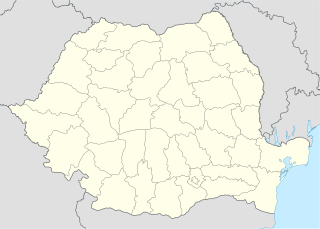| Location | Câmpul Morii, [1] Jigodin, Harghita, Romania |
|---|---|
| Coordinates | 46°20′N25°48′E / 46.34°N 25.80°E Coordinates: 46°20′N25°48′E / 46.34°N 25.80°E |
| Site notes | |
| Condition | Ruined |
| Reference no. | HR-I-s-B-12641 [1] |
It was a Dacian fortified town.
| Location | Câmpul Morii, [1] Jigodin, Harghita, Romania |
|---|---|
| Coordinates | 46°20′N25°48′E / 46.34°N 25.80°E Coordinates: 46°20′N25°48′E / 46.34°N 25.80°E |
| Site notes | |
| Condition | Ruined |
| Reference no. | HR-I-s-B-12641 [1] |
It was a Dacian fortified town.

Harghita is a county (județ) in the center of Romania, in eastern Transylvania, with the county seat at Miercurea Ciuc.

Atid is a commune in Harghita County, Romania. It lies in the Székely Land, an ethno-cultural region in eastern Transylvania.

The Székely Land or Szeklerland is a historic and ethnographic area in Romania, inhabited mainly by Hungarians. Its cultural centre is the city of Târgu Mureș (Marosvásárhely), the largest settlement in the region.
The Toplița is a river in the Călimani Mountains, Harghita County, central Romania. It is a right tributary of the river Mureș. It joins the Mureș in the town Toplița. It is fed by several smaller streams, including Lomășița, Puturosu, Purcelu, Voievodeasa, Hurdugașu, Creanga and Fagul Rusului.
The Măgheruș is a small river in the Gurghiu Mountains, Harghita County, central Romania. It is a left tributary of the river Mureș. It flows through the municipality Toplița, and joins the Mureș in the town Toplița, where it is channelized. Its name is from the Hungarian "mogyoró", and means "Nutty Creek".
The Gălăuțaș River is a small river in the Gurghiu Mountains, Harghita County, central Romania. Its name is from the Hungarian "galóca", meaning "amanita" (mushroom). It is a left tributary of the river Mureș. It flows through the municipality Gălăuțaș, and joins the Mureș in the village Gălăuțaș.
The Voșlăbeni is a small river in the Hăşmaş Mountains, Harghita County, central Romania. It is a right tributary of the river Mureș. It flows through the village of Voșlăbeni,
The Firtuşu gas field is a natural gas field located in Lupeni, Harghita County, Romania. It was discovered in 1966 and developed by Romgaz. It began production in 1970 and produces natural gas and condensates. The total proven reserves of the Firtuşu gas field are around 100 billion cubic feet (2.8 km³), and production is centered on 30 million cubic feet/day (0.85×105m³).
The Bențid gas field is a natural gas field located in Șimonești, Harghita County. It was discovered in 1964 and developed by Romgaz. It began production in 1966 and produces natural gas and condensates. The total proven reserves of the Bențid gas field are around 100 billion cubic feet (2.8 km³), and production is centered on 30 million cubic feet/day (0.85×105m³).
The Cuşmed gas field is a natural gas field located in Atid, Harghita County. It was discovered in 1967 and developed by Romgaz. It began production in 1968 and produces natural gas and condensates. The total proven reserves of the Cuşmed gas field are around 75 billion cubic feet (2.1 km³), and production is centered on 20 million cubic feet/day (0.57×105m³).
The Brădeşti gas field is a natural gas field located in Brădeşti, Harghita County. It was discovered in 1965 and developed by Romgaz. It began production in 1966 and produces natural gas and condensates. The total proven reserves of the Brădeşti gas field are around 74 billion cubic feet (2.1 km³), and production is centered on 20 million cubic feet/day (0.57×105m³).
The Lueta mine is a large open pit mine in central Romania in Harghita County, 36 km west of Miercurea Ciuc and 299 km north of the capital, Bucharest. Lueta represents one of the largest iron ore reserves in Romania having estimated reserves of 6 million tonnes of ore. The mine produces around 10,000 tonnes of iron ore/year.

The Târnava Mare is a river in Romania. Its total length is 223 km, and its drainage basin area is 3,666 km2. Its source is in the Eastern Carpathian Mountains, near the sources of the Mureș and Olt in Harghita County. It flows through the Romanian counties of Harghita, Mureș, Sibiu, and Alba. The cities of Odorheiu Secuiesc, Sighișoara, and Mediaș lie on the Târnava Mare. It joins the Târnava Mică in Blaj, forming the Târnava.

It was a Dacian fortified town.

It was a Dacian fortified town.

It was a Dacian fortified town.

It was a Dacian fortified town.

It was a Dacian fortified town.

It was a Dacian fortified town.
The Cristur gas field is a natural gas field located in Cristuru Secuiesc, Harghita County. It was discovered in 1920 and developed by and Romgaz. It began production in 1930 and produces natural gas and condensates. The total proven reserves of the Cristur gas field are around 852 billion cubic feet (24 km³), and production is slated to be around 52.5 million cubic feet/day (1.5×105m³) in 2010.
| This Dacia-related article is a stub. You can help Wikipedia by expanding it. |
| This article relating to archaeology in Europe is a stub. You can help Wikipedia by expanding it. |